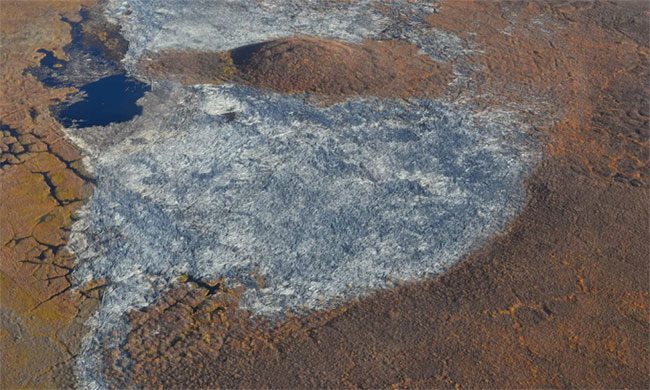The deadwood mass consists of countless fallen trees and ancient wood accumulated on the river in Nunavut, spanning an area of 51 km2 and containing 3.1 million tons of carbon.
A team of scientists from Colorado State University utilized high-resolution satellite imagery and artificial intelligence (AI) to map the world’s largest logjam in the Mackenzie River Delta in Nunavut, the largest and most remote territory in northern Canada, as reported by IFL Science on April 14. The new study was published in the journal Geophysical Research Letters.

The Mackenzie River Delta in Canada has the largest deadwood accumulation in the world. (Photo: Alicia Sendrowski).
This deadwood mass spans up to 51 km2, comprising numerous fallen trees and ancient wood accumulated on the river. Scientists believe that its impact on Earth’s carbon cycle is much greater than previously thought. The entire deadwood mass is nearly as large as Manhattan and can be divided into 400,000 small sections, with the largest section equivalent to 20 football fields.
Trees act as a carbon reservoir for the Earth, absorbing CO2 from the atmosphere and storing it in wood. Thus, they significantly influence greenhouse gas levels in the atmosphere and climate change. However, according to the research team, deadwood masses are often overlooked when assessing their broader environmental impact.
“We need to study such deadwood masses, not only for the carbon cycle but also to understand how natural river systems operate, how rivers transport and distribute wood,” said Virginia Ruiz-Villanueva, a geomorphologist at the University of Lausanne.
The new study estimates that the deadwood mass in the Mackenzie River Delta stores about 3.1 million tons of carbon—a significant amount even on a global scale. “That figure is equivalent to the emissions from about 2.5 million cars in a year,” explained engineer Alicia Sendrowski from Colorado State University, who led the research.
The study only measured the surface area of the deadwood mass and could not calculate the portion of wood hidden below, meaning the actual scale of this carbon reservoir could be even larger. Wood accumulates here for several reasons.
Firstly, drifting objects in the Arctic are often transported over vast areas due to large northern forests and high-latitude river networks. Moreover, the Mackenzie River Delta is very wide, allowing deadwood to accumulate. Finally, the cold and dry conditions of the Arctic enable wood to remain in almost perfect condition for thousands of years. The research team noted that some trees in the deadwood mass appeared to have fallen just last winter, but in reality, they have existed for decades or even centuries.





















































